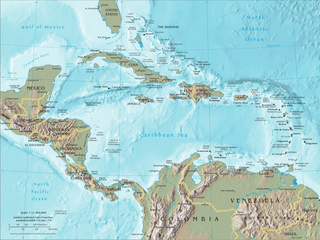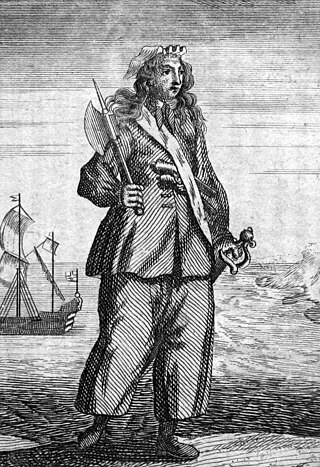This article needs additional citations for verification .(February 2022) |
See also 1719 in piracy, 1721 in piracy and Timeline of piracy.
This article needs additional citations for verification .(February 2022) |
See also 1719 in piracy, 1721 in piracy and Timeline of piracy.

The era of piracy in the Caribbean began in the 1500s and phased out in the 1830s after the navies of the nations of Western Europe and North America with colonies in the Caribbean began hunting and prosecuting pirates. The period during which pirates were most successful was from the 1660s to the 1730s. Piracy flourished in the Caribbean because of the existence of pirate seaports such as Port Royal in Jamaica, Tortuga in Haiti, and Nassau in the Bahamas. Piracy in the Caribbean was part of a larger historical phenomenon of piracy, as it existed close to major trade and exploration routes in almost all the five oceans.

Bartholomew Roberts, born John Roberts, was a Welsh pirate who was, measured by vessels captured, the most successful pirate of the Golden Age of Piracy. During his piratical career, he took over 400 prize ships. Roberts raided ships off the Americas and the West African coast between 1719 and 1722; he is also noted for creating his own pirate code, and adopting an early variant of the Skull and Crossbones flag.

John Rackham, commonly known as Calico Jack, was an English pirate captain operating in the Bahamas and in Cuba during the early 18th century. His nickname was derived from the calico clothing that he wore, while Jack is a nickname for "John".

Mary Read, was an English pirate about whom there is very little factual documentation. She and Anne Bonny were among the few female pirates during the "Golden Age of Piracy".

Anne Bonny, sometimes Ann Fulford, and Ann Bonn, was a pirate operating in the Caribbean, and one of the few female pirates in recorded history. What little that is known of her life comes largely from Captain Charles Johnson's 1724 book A General History of the Pyrates, though the information presented by Johnson about her is considered dubious.

Edward England was an Irish pirate. The ships he sailed on included the Pearl and later the Fancy, for which England exchanged the Pearl in 1720. His flag was the classic Jolly Roger — almost exactly as the one "Black Sam" Bellamy used — with a human skull above two crossed bones on a black background. Like Bellamy, England was known for his kindness and compassion as a leader, unlike many other pirates of the time.

The Golden Age of Piracy is a common designation for the period between the 1650s and the 1730s, when maritime piracy was a significant factor in the histories of the North Atlantic and Indian Oceans.

Thomas Anstis was an early 18th-century pirate, who served under Captain Howell Davis and Captain Bartholomew Roberts, before setting up on his own account, raiding shipping on the eastern coast of the American colonies and in the Caribbean during what is often referred to as the "Golden Age of Piracy".

Charles Vane was an English pirate who operated in the Bahamas during the end of the Golden Age of Piracy.
Henry Jennings was an English privateer-turned-pirate. Jennings' first recorded act of piracy took place in early 1716 when, with three vessels and 150–300 men, Jennings' fleet ambushed the Spanish salvage camp from the 1715 Treasure Fleet. After the Florida raid, Jennings and his crew also linked up with Benjamin Hornigold's "three sets of pirates" from New Providence Island.
See also 1717 in piracy, 1719 in piracy, and Timeline of piracy.
See also 1718 in piracy, 1720 in piracy, 1719 and Timeline of piracy.
True Caribbean Pirates is a documentary which aired on The History Channel in 2006.

John Phillips was an English pirate captain. He started his piratical career in 1721 under Thomas Anstis, and stole his own pirate vessel in 1723. He died in a surprise attack by his own prisoners. He is noted for the articles of his ship, the Revenge, one of only a few complete sets of pirate articles to survive from the so-called Golden Age of Piracy.

The capture of John "Calico Jack" Rackham was a single-ship action fought between English pirate Calico Jack and British privateer Jonathan Barnet. The battle was fought in the vicinity of Negril, Jamaica and ended with the capture of Rackham and his crew.

The Battle of Cape Lopez was fought in early 1722 during the Golden Age of Piracy. A Royal Navy ship of the line under the command of Captain Chaloner Ogle defeated the pirate ship of Bartholomew Roberts off the coast of Gabon, West Africa.

The Flying Gang was an 18th-century group of pirates who established themselves in Nassau, New Providence in the Bahamas after the destruction of Port Royal in Jamaica. The gang consisted of the most notorious and cunning pirates of the time, and they terrorized and pillaged the Caribbean until the Royal Navy and infighting brought them to justice. They achieved great fame and wealth by raiding salvagers attempting to recover gold from the sunken Spanish treasure fleet. They established their own codes and governed themselves independent from any of the colonial powers of the time. Nassau was deemed the Republic of Pirates as it attracted many former privateers looking for work to its shores. The Governor of Bermuda stated that there were over 1,000 pirates in Nassau at that time and that they outnumbered the mere hundred inhabitants in the town.
Charles Yeats was a pirate active in the Caribbean. He is best known for sailing alongside and then abandoning Charles Vane.
Richard Tookerman was born on 16 May 1691 in Devon, Cornwall, England. He was the son of Josias Tookerman, a clergyman, and younger brother of Josias Tookerman II, a clergyman sent by the Society for the Propagation of the Gospel (SPG) to Jamaica. He married Katherine Grant, widow of John Grant of Charleston, South Carolina by 1717. As a pirate, smuggler, and trader active in the Caribbean and the Carolinas, he became best known for involvement with pirates Stede Bonnet and Bartholomew Roberts.
Daniel Porter was a pirate and trader active in the Caribbean. He is best known for his associations with Benjamin Hornigold and Bartholomew Roberts.